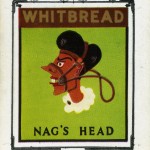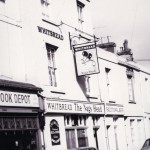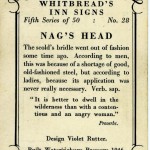The Nags Head Gensing Road
By John Hodges
The first reference to the parish of St.Leonard occurs in 1372, it is contained within a return of the parish churches in the liberty of Hastings made by the Bailiff. Although this ancient church appears to have disappeared sometime in the fifteenth century, it can be placed in the present day Norman Road. During the construction of the recently redundant Methodist church the existence of such a building was confirmed when the old graveyard was disturbed. When James Burton first decided to build his new town on part of the old Manor of Gensing, it straddled two parishes. That of St.Leonard was one, whilst the other was St Mary Magdalene named not after an ancient church, but more likely after the old hospital of that name, long since disappeared but the revenues of which continue to form the basis of Hastings oldest charity. It was in 1828 that James Burton obtained from the estate of Charles Eversfield the land upon which St.Leonards was developed. The original boundaries of his purchase had a frontage of 1151 yards to the sea and contained several pockets of land with names pertaining to their location such as Chapel Field, Under the Cliff, and Old Woman’s Tap Shaw. We know that construction commenced in early 1828 with the foundation stone of the St.Leonards Hotel being laid, but the first building to be completed was James Burton’s own house at 57, Marina. This was followed by the completion of the South Colonnade and the eastern boundary Archway, both now long gone. By August 1829 three houses in St.Leonards, the Harold Hotel, the St.Leonards Hotel, and the first true public house the Horse and Groom had all been licensed. St.Leonards was really beginning to take shape.

However James Burton’s original concept for the new town of St.Leonards did not materialise quite as he had envisaged. Although provision was made for agricultural workers in Caves Road, Ostlers and grooms at Harold Mews, and even for the washerwomen to ply their trade in the newly constructed Lavatoria, accommodation could not be found within St. Leonards for all of the work force necessary to support such an expanding community. St. Leonards Without was the term used by Burton to describe the building activity that took place outside of the official boundary. This home spun construction industry, which is probably its most accurate description, certainly did not figure in Burton’s original plan. However, the impracticality of assembling a daily labour force from miles away soon dawned upon him, and the scheme received his tacit agreement. In fact much of Burton’s planning, whilst architecturally magnificent, lacked any form of consideration in terms of economic or logistic sustainability beyond the short term labour market created by the development of his town.

It was in the environs of “St.Leonards Without” that the business and commerce that could provide sustainability for this new town first started. The influx of the many tradesmen and merchants needed to build a town, many blessed with entrepreneurial vision, soon saw a future for their skills beyond the current construction phase in offering those same skills and materials to the new population. And so many of the streets were developed as a mixture of residents and traders, with one such typical example being Gensing Road. Began in 1832 to house many of the workers engaged in the construction of the new town, its development epitomised the hopes of a home and a new future for the many deprived families coming from the shanties of the old America Ground. Several of the streets in this part of St.Leonards contained houses that were literally built with materials dragged up from the old America Ground, whilst the sandstone used to supplement the construction was quarried from what is now the site of Christchurch. The Nags Head, which opened around 1835, was the first of several small public houses to be built outside the St. Leonards boundary actually backing onto the town wall itself.
There is no evidence to suggest that there was ever a brewery attached to the Nags Head, it is far more likely that its principal product was purchased from one of the local breweries. The Crown Brewery, just a few yards distant in Shepherd Street opened in 1831, and it was quite possibly this facility together with the fairly liberal provisions of the recent Beerhouse Act of 1830 that gave birth to the Nags Head, and several other small hostelries in the back streets of the newly developing St.Leonards. By 1855 James “Jesse” Hack, the son of the well known landlord of the Victoria Inn at Hollington had become the Landlord of the Nags Head, a man well schooled in the art of the Licensed Victualler. Jesse Hack senior a most enterprising character known locally for his road building activities, was always quick to see an area of commercial opportunity. By involving his family in one of the leading hostelries that served this bustling community, it provided him with a steady supplement to his other sources of income from Hollington.

By the middle of the 19th Century Eldridge and Young were now brewing at the Crown Brewery around the corner in Shepherd Street, and it is likely that successive landlords would have continued their patronage of this the most local of all breweries. The early customers would have enjoyed these locally brewed beers for many years until the brewery went into voluntary liquidation in 1907, but continued to brew until 1913. At this point Breeds & Co. Ltd. the local brewers from Hastings Old Town took over the leasehold of the tied houses, but the brewery itself closed. It can only be presumed on the basis of normal business practice in such circumstances, that Breeds also took over the order book that represented the independent public house trade, including hostelries such as the Nags Head. In 1920 further change occurred in the drinking habits of the customer base, when the owner of the Nags Head, a Mr. Rogers, sold the freehold of the premises to Jude Hanbury the Wateringbury brewer. But once again this state of affairs did not last for very long when ten years later the Nags Head, together with the other six houses owned by Jude Hanbury in East Sussex, were sold to Frederick Leney & Sons Ltd, who by this time were part of the emerging Whitbread brewing empire. Probably the reason for this sale could be found in the move of Jude Hanbury from Wateringbury to Canterbury in 1924, coupled with Whitbread’s desire to zone their trading names in the interest of distribution logistics, and the loyalty bonus provided through parochialism of trade. Whitbreads remained the trading name for many years until in 1961 the shares, which still remained in the name of Leneys, were sold to Fremlins of Maidstone yet another one of Whitbreads trading arms. At sometime during the 1980s the pub was sold on and eventually closed in 1989, but reopened two years later in the ownership of one of the new breed of pub company.
During the years leading up to the First World War the pub had become a social centre for many ordinary working people where they could gather and discuss the issues of the day. One such occasional customer was an Irish house painter by the name of Robert Noonan who spent part of his tragically short life in Hastings where under the name of Robert Tressell he added a truly original contribution to the socialist cause, satirising the iniquitous system under which working class people existed. In this work called The Ragged Trousered Philanthropists he affords the working man a dignity, and creates for him a standing in Society so long denied to him by those he served. It was the Nags Head of all those years ago that provided the setting for the organisation of the annual beano for Tressell’s working philanthropists , one of the more pleasant aspects of his description of their working Life. But even this agreeable interlude in the monotony of Edwardian drudgery still remains a far cry from the comparative luxuries one would now find in this very pleasant public house, as it continues to minister to the needs of the discerning drinking man after a history stretching back nearly one hundred and eighty years in the “new town” of St.Leonards.
Hastings Town February 2012
All articles, photographs, films and drawings on this web site are World Copyright Protected. No reproduction for publication without prior arrangement. (Hard Copy Back Numbers Still Available) © World Copyright 2015 Cinque Ports Magazines Rye Ltd., Guinea Hall Lodge Sellindge TN25 6EG
